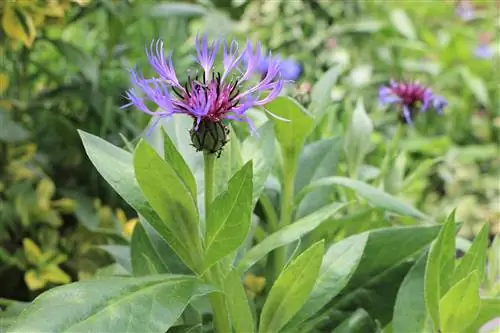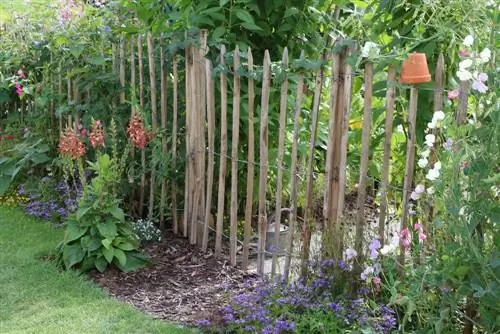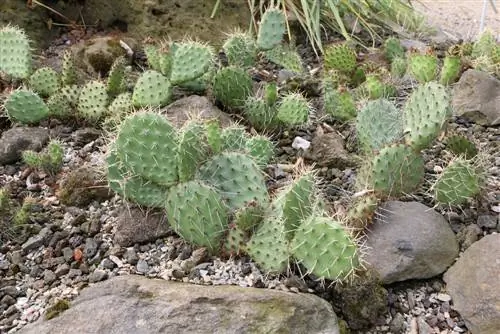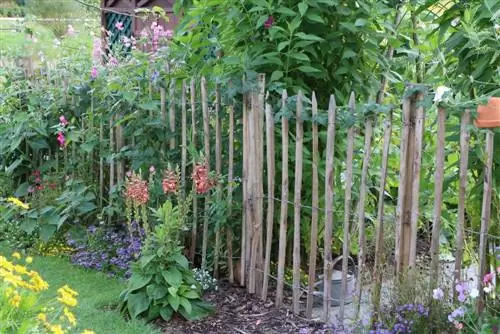- Author admin [email protected].
- Public 2023-12-17 03:39.
- Last modified 2025-01-24 12:45.
The knapweed (Centaurea), which originally comes from America and now occurs mainly in Europe, the Mediterranean region or western Asia, has around 500 species. The cornflower is also one of these species.
Within the knapweed family there are annual, biennial or perennial varieties. They can reach heights of between 20 cm and 3 meters and have very different appearances. Please note: Knapweed may be regionally protected and may not be picked!
Special features of the knapweed
Basically, every knapweed, no matter what type it is, shows its flower in the so-called head shape. This means that they have at least ten flowers and the small leaves are attached to them with small appendages. Only in the Carduoidaea - plants of a subfamily - are there tubular flowers. The knapweed is most commonly found in Central Europe as a cornflower, but this is in sharp decline due to monoculture. The meadow knapweed is also common - depending on the region, you can find the scabious knapweed and the black knapweed.
Example: mountain knapweed
The mountain knapweed (Centaurea montana) also belongs to the knapweed family. It reaches an average height of between 20cm and 50cm and forms a so-called single-headed stem. It has oval leaves with smooth edges that look slightly grayish and rough. While the petals are red with blue edges, the bracts are green.
By the way
In folk medicine, the mountain knapweed was used as medicine.
Centaurea montana is a perennial plant that, according to its name, occurs in the mountains of central to southern Europe. There it can be found at altitudes between 500 meters and 2,200 meters. It can most often be discovered in the sub-alpine levels of the mountains, for example in Austria in the so-called upper montane regions of Styria or Carinthia. She loves sparse forests and fresh meadows. In these locations it blooms between May and August.
Knapweed varieties in the garden
Knapweeds can also be planted in your own garden by sowing them. The best known is the annual cornflower, the more wild variety is the mountain knapweed. Spring is just the right time for sowing and the seeds can be sown in the cold frame from March onwards. A few weeks later it will also be available in garden centers as a container plant and can be planted in this form immediately in the garden at any time. Its pastel-colored flowers in shades of pink to blue enrich any flower bed. The flowers appear between May and July.
A bed with nutrient-rich soil and a sunny location are just right as a location in the garden. The knapweed doesn't place any more demands on its place. The knapweed looks very beautiful in a cottage garden, here it fits in with the other typical flowers such as lady's mantle, delphiniums or lupins.
Tip:
The knapweed can also be propagated by dividing the rhizome.
The mountain knapweed comes in several varieties, they also differ in the color of their flowers. The white mountain knapweed, for example, is more able to tolerate a period of drought and continues to bloom again throughout the summer. The pink mountain knapweed even smells like peaches and is therefore particularly popular with lovers of fragrant plants in the garden. Since the mountain knapweed is not only available in different colors, but also in different heights, this detail should also be taken into account. For example, this can also be used to plant the bed in the background, so the garden owner has optimally planted his areas and can enjoy different types of mountain knapweed not only at different times, but also at different times.
The tall, purple-red Centaurea montana “Merel” is particularly suitable for background planting, as it is not only the darkest of its kind but also tall. It can grow up to half a meter high and also develops a lovely scent, especially in the sun. The C. montana “Purple Rose”, which is not so dark but produces lilac-colored and slightly feathery flowers, can also be planted in the background bed due to its similar height.
The large Centaurea macrocephala - also known as the giant knapweed - almost looks like an artichoke. The large flower heads sit on thick stems and shine a bright yellow. It can reach heights of up to 150 cm. The stems can be cut and incorporated into autumnal bouquets. Once again the individual varieties at a glance:
- Mountain knapweed in blue
- Dark Knapweed
- light yellow variety especially for planting on slopes
- Caucasian flake, suitable for a wild garden
- Red mountain knapweed, a rare form
- Giant Knapweed
- Wig knapweed with “blonde” hair on the outside of the flower heads
Care in the garden
When knapweeds are planted in the home garden, they should be placed in the location that most closely matches their type. This should be as sunny to partially shaded as possible, although partial shade is not as favorable for flower formation as sun. The soil of the site should be nutrient-rich, which is why it is advisable to add compost to it in spring. When knapweeds are sown, spring is of course the best time. The seeds can be sown in the cold frame from March, but sowing directly into the flower bed only makes sense from May. If you buy a container plant from a garden store, it can be planted at any frost-free time of year. Due to their delicate size, the corresponding short-growing varieties are most beautiful when planted in a group.
Removing spent parts can promote new flower growth. Radical pruning after flowering can also stimulate lush growth. If stems are cut off for the vase, you get long-lasting fresh flowers in the living room.
Tip:
Don't cut back in autumn, let it soak in promotes growth in spring.
Knapweeds are not only busy and grateful bloomers, they are also insensitive to pests. Only if there have been more rainy days and days with little sunshine during the year can the knapweed be affected by powdery mildew.
Conclusion of the editors
Due to its diversity, the knapweed is a plant that can be planted in the garden to suit everyone's taste. Wild plants should not be dug up. You can either sow them or buy them as young plants in a container. They are easily propagated by dividing the rootstock. Depending on the variety of knapweed, it can be used differently in a garden. However, the preference for sun and nutrient-rich soil should be taken into account.
Tips for speed readers
- Knapweeds come in many different varieties.
- They reach heights from 20 cm, the largest is 150 cm high.
- The variety of colors ranges from yellow to pink, purple, violet and crimson red.
- The annual cornflower is the best known of the family.
- Knapweeds are perennial.
- They can be used by sowing or as young plants.
- They can be propagated by root division.
- They love sun and nutrient-rich soil.
- Knapweeds are suitable for natural gardens, cottage gardens, gravel gardens, flower meadows, flower beds and much more.
What you should know about the cornflower in brief
- A common species of knapweed in this country are the cornflower and the meadow knapweed. All species have a wildflower character. The cornflower comes from Sicily and was probably spread with grain during the pile-dwelling period, especially in and around cornfields.
- The soil should be well-drained, calcareous and rich in humus for the cornflower.
- The flower prefers a sunny to partially shaded, sheltered location.
- The plant can tolerate some drought temporarily, but should otherwise be watered regularly.
- When watering, avoid wetting the leaves to prevent mildew.
- If necessary, the cornflower can also cope with heavy soil.
- Tall species are best supported with a perennial holder so that they do not fall over.
- Propagation takes place by sowing outdoors in spring or autumn. You can also divide the perennials.
The flowers of the cornflower can be used for reddened eyelids or tired eyes by preparing an infusion for a compress. You can also use it as a bath additive for delicate, quickly reddening skin.






